This is a guest post by Ben Carter, General Manager of Cityhop
The future of mobility is an internationally hot topic. New Zealand has several ride share, e-scooter, bike share, and car share operators. Twitter and council chambers around the country have all debated the value these modes bring to a city.
It is often hard to keep up with all the new and quickly changing mobility movements – especially in car share. For example, there are three very different modes under the car share umbrella; peer to peer, round-trip, and free-floating. Despite using the same term ‘carshare’, the impacts and benefits delivered to the city and community couldn’t be more different.
- Peer to peer carsharing such as YourDrive is when a private individual rents out their car to another user – It’s the Airbnb of rental vehicles. Peer to peer car-sharing is generally regarded as a rental car and left out of car share policies.
- Round-trip carsharing such as Cityhop, is when a user books a vehicle from a dedicated location and returns the vehicle to the same location when finished. Round-trip is the largest and longest operating model worldwide.
- Free-floating carsharing is similar to a Lime Scooter, you opportunistically unlock the closest one to you, and when finished, leave it within a specified homezone. Free-floating (being trialled by Mevo in Wellington) is the new model on the block, however research suggests it cannibalises public and active transport modes and doesn’t bring any other benefits to a city. Its nick name is self-drive taxi.
Round-trip car share is the great tool for a city wanting to reduce car ownership, reduce vehicle kilometres travelled, and increase modal shift. It’s estimated that every $1 invested by the City of Sydney into round-trip car has returned $6.16. Mobility futurist Tim Papandreou goes as far to say, “round-trip car sharing is the only proven tool that can change the congestion situation and create the drop needed in car ownership”. Many free-floating operators claim the same benefits, but as you will see the below the data and research does not support their claim – and they are a wolf in sheep’s clothing.
TLDR;
- Round-trip car sharing is a great addition to a city and its mobility goals
- Free-floating car share cannibalises active and public transport…let’s look into the data
1. Reducing vehicle ownership
The general finding is that every round-trip carshare vehicle removes 9-15 privately owned vehicles off the road. Some free-floating operators claim similar benefits – but these are unfounded.
In a German case study comparing round-trip and free-floating car share members there was a staggering difference in vehicle ownership behaviour;
Figure 1: Car ownership behaviour after joining car share clubs
The below data was reported in a German Case study of 1,122 carsharing customers
Similar findings were reported in a Vancouver study into local operators;
Figure 2: Vehicles per household prior and after joining a car share program in Vancouver.
Auckland Transport has conducted two surveys on Cityhop members, one in 2014 and one in 2018. It was interesting to see the global data and trends reflected locally. The survey data indicated that 38% of Cityhop households in in 2014, and 33% in 2018 had reduced the number of cars owned or now lived without a car! If we assume the respondents are representative of the entire member base, that would equal between 1200-1500 private vehicles off the road.
Figure 3: Cityhop members private car ownership behaviour
The below data is taken from Auckland Transport’s 2014, and 2018 survey of Cityhop users
2. Modal Shift
Getting people out of cars, and into public and active modes is a goal of every major city. Car share is an important tool for cities to encourage mode-shift, as it gives people another transport option just in case (cough train ‘signal issues’). Because of this, round-trip car share has been found to increase public and active transport use internationally.
On the other hand, it becomes apparent that free-floating car share cannibalises public and active transport modes. In cities such as Vancouver, free-floating car share vehicles are described as ‘drive-yourself-taxis’, as users simply drive themselves instead of walking or waiting for public transport.
Figure 5: Public Transport Behaviour:
The below research was carried out on 1,122 carsharing customers in Germany .
Similar trends are seen in other Cities internationally. In Switzerland free-floating car share members walk, bus and train less after joining. On the other hand, round-trip car share members walk, bus and train more after joining.
Figure 6: Perceived change in mode use through the car-sharing membership
(free-floating N=337, station-based N=380)
Looking at the international data, it becomes evident that free-floating car share cannibalising active and public transport modes. Other examples can be found in the America’s, such as Seattle. Here members of the free-floating Car2Go reduce active and public transport use after joining (Figure 7).
Figure 7: Transport modes of Car2Go (free-floating) members since joining
The data from around the world demonstrates the same behaviour – free-floating car share undermines the public and active transport investments a city makes. When a user thinks it is more convenient to drive a car over active or public transport, they replace the mode with a vehicle trip.
The opposite behaviour is seen in round-trip car share members – they increase their active and public transport use. This is corroborated locally in Auckland, where Cityhop (round-trip) members reported a significant increase in both active and public transport use after joining (Figure 8, 9).
Figure 8: Cityhop (round-trip) members use of other transport options since joining
3. Reduced Vehicle Kilometres Travelled (VKT)
Reducing vehicle kilometres travelled is another important goal for a city – and another benefit round-trip services provide. With less VKT, there are fewer cars on the road (congestion), fewer road accidents (trauma), and fewer emissions produced (CO2-e) – which all provide a value back to a City.
Round-trip car share users from the City of Sydney reported to travel 2,000km less after joining . The Philip Boyle report into The Impact of Car Sharing Services in Australia calculated that every VKT reduced provided $0. 307 of benefits to a city, as seen below;
Figure 9: Summary of benefits and values related to lower VKT
See, The Impact of Car Share Services in Australia
If we assume that Cityhop car share members have the same behaviour as GoGet (Australia’s largest operator) car share members, every year these members:
- Provide over $2,500,000 in value from reduced VKT, and
- Reduce their CO2 Emissions by over 1,600,000 kg CO2-e
You can probably guess that if a free-floating car share service doesn’t reduce car ownership, and doesn’t increase public/active transport, that it won’t reduce VKT. And the data would suggest that you are right. When users replace public and active transport modes with a vehicle journey, the mode is creating vehicle kilometres travelled – not reducing. Figure 10 highlights that users don’t report any significant change in driving behaviour. Research comparing free-floating members with non-car sharing members found very little difference in driving behaviour. Figure 11 details how free-floating members had a similar number of trips, distance travelled, and trip duration as a private vehicle! Not the behaviour a City would want to encourage.
Figure 10: Perceived change in mode use through the car-sharing membership
(free-floating N=337, station-based N=380)
Figure 11: Free-floating and non-car sharing users compared
(Free floating N=109, Non-car shar users N=95)
Conclusion:
The Philip Boyle report into The Impact of Car Sharing Services in Australia described each round-trip car share vehicle as providing $48,000 of net value to the City of Sydney – a $6.16 return on ever $1.00 of invested (Figure 12). How many local transport initiatives can boost a positive return like this?
Figure 12: Summary of Economic Analysis
See, The Impact of Car Share Services in Australia:
Round-trip car share has been proven locally and internationally to be a great tool for cities wanting to get people out of their private car, and into public and active transport. To date, these services have received minimal support from local government unlike the city of Sydney. It seems counter intuitive to reduce cars and congestion by adding more cars – but round-trip car share services like Cityhop work!
The only thing restricting a precipitous drop in congestion and car ownership from a much bigger car share service is transport policy.

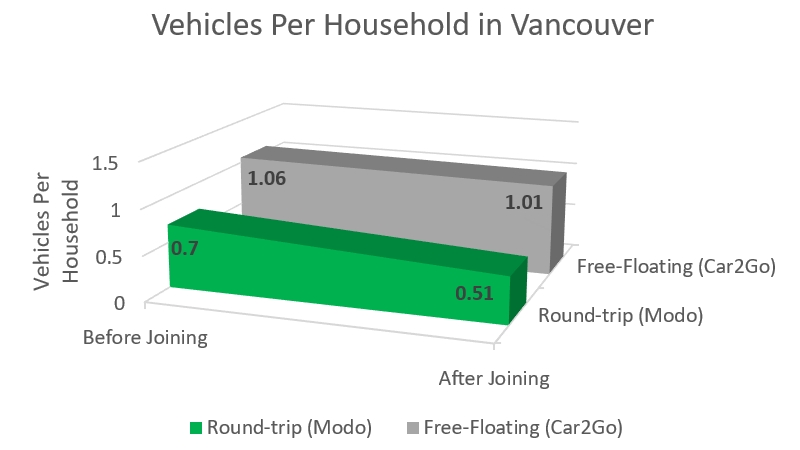
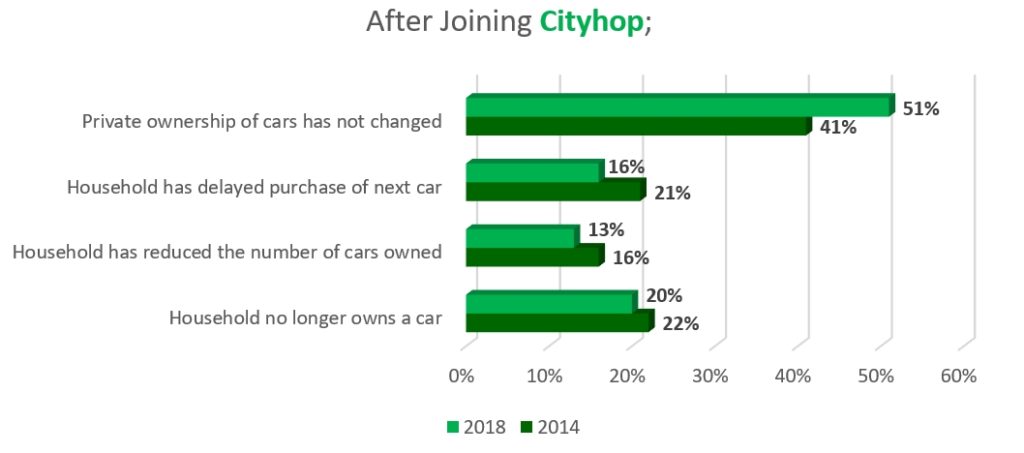

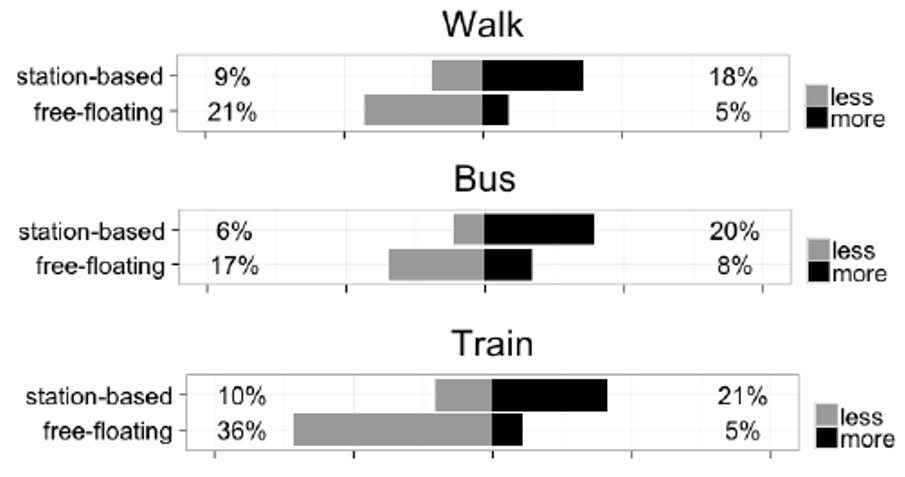
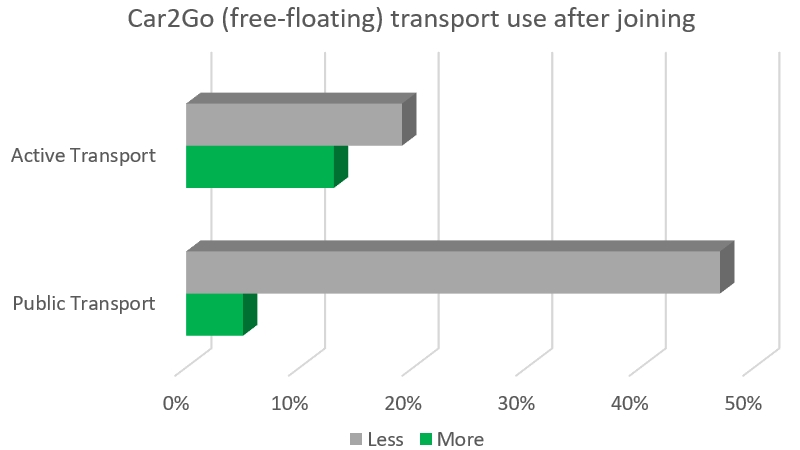

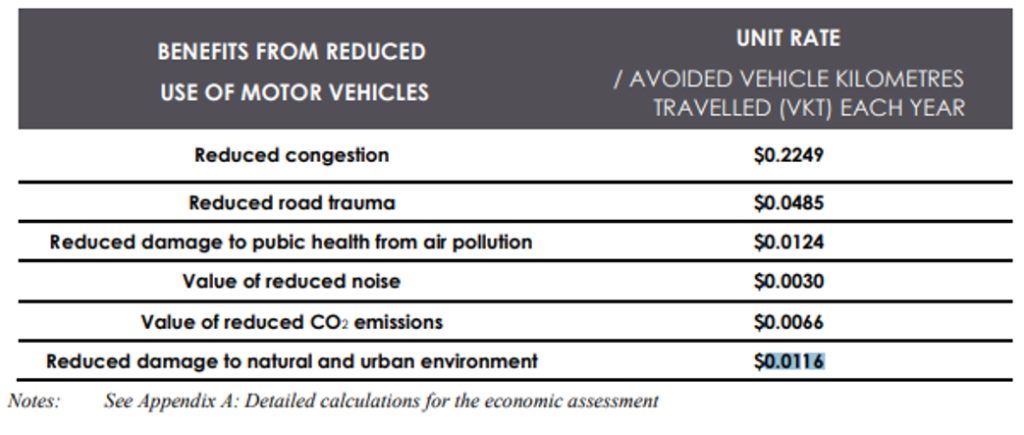


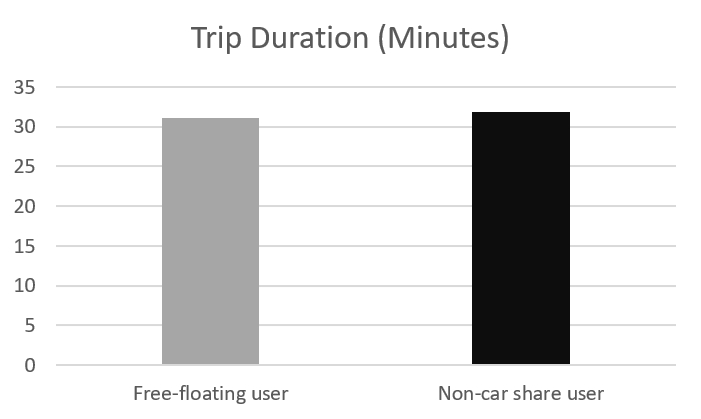

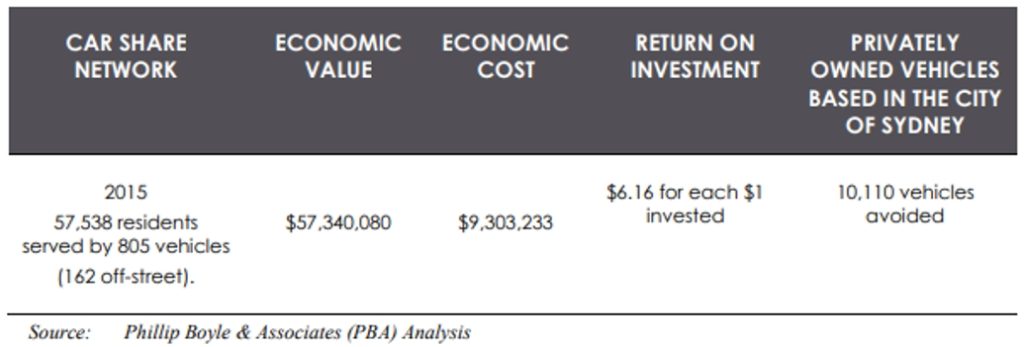

 Processing...
Processing...
We will be going car free (again) in November but I still need some convincing on the end to end trip aspect. To me it feels like a bad bus timetable – the need to commit to times and have the anxiety that comes with that.
When we lived in Vancouver we used the skytrain and buses for everything because they had a good network, and only actually used car2go once to try it out and appreciated that at our destination we could park the car and then have the freedom to dawdle or get the train back home.
I picture being at my parents house and feeling the need to leave not because I want to, but because my booking is coming up, and I hate those feelings!
I’ve had a fairly good look at cityhop, and the booking system feels like a barrier, though I understand the need. We are just not people that plan in advance for the use of a car – it’s more likely a whim or desire to go somewhere on a nice day that we can’t get to otherwise.
Does the city hop system allow for walking up to a car, booking it right there and then and driving off? Is there any concept of an open ended booking (perhaps ‘rest of today’)?
For us it will be a mix of mostly walking and cycling, buses, Uber in emergencies/short trips, car share for trips too slow or awkward by transit and finally rental cars for longer trips.
Maybe there’s a way the pricing model could be changed to allow booking for longer than you think you need, and then having some of the rate refunded if you return it early?
I’m looking at the details again because my husband’s car is on Trademe on a no reserve auction, so the rarely used beast will no longer be hogging driveway space. I’ll probably join with the current offer for free membership / higher hourly rates plan and only switch to the other if we find we use it. It could be that the few times we need a car, a rental car or a taxi will often fit our needs, and the Cityhop will only be the best option a few times a year.
That might the case for you, too, but since membership seems to be free at the moment, there’s no harm in having it as an option.
From what I can tell yes, if you walk up to a car, you can book it right there and drive off.
Our business (200+ employees, consultancy) uses Cityhop extensively – I’ve been using it as part of work for 5 years or more. As well as the general pool of cars, we have a vehicle parked next to the building dedicated for us (possibly not outside work hours, not sure).
The booking system is easy and quick, and works well for both advance booking and immediate needs. For the latter, I have found that there has never been a time I can’t access a car for a last-minute meeting – there are several Cityhop’s with a 10 minute walk (CBD fringe).
For work (time-chargeable) journeys attending meetings between 3km and 30-40km’s away and less than say 4 hours it really is a winner – short journeys are better by Uber, bus or cycle, longer journeys by ‘conventional’ hire car when needed.
[Declaration – no paid influence, just a happy customer….]
TimR , question do these vehicles have a cof or wof ? , as you have to hire them then they are classed as a commercial vehicle so don’t touch them if a wof is showing .
“For example, there are three very different modes under the car share umbrella; peer to peer, round-trip, and free-floating”.
What about “one-way” car share? YooGo works like this, using EVs, mostly in Christchurch, and can be cost effective and convenient.
Interesting post, thanks. Fascinating that the details of the scheme can so largely influence the effect on users’ behaviour (either having them walk and use public transport more, or less). I’m glad people are researching that. I’m sure details affecting outcome in this way is typical in transport planning, like wayfinding and pedestrian amenity details having a big impact on public transport ridership.
Interesting post. Some good things to chew on that i hadn’t really thought about before. Free floating car share instinctively sounds the most useful however the point about it cannabalising PT and walking is very true. The research seems to back it up as well.
Where i think the ‘return to base model works well is when those bases are:
-near workplaces with little or no off-street parking (essentially become fleet vehicles (although we have to be careful that this doesn’t cannibalise walking moderate distances as well); and
-near apartments. If a 100 unit car park can do away with 100 car parks and have i dunno 5? Carshare spots… then i’m all for it.
This is where the carshare policy intersects with future parking requirements big time.
Everyone with half a clue knows that parking is generally a subsidy to the motorist borne by all… If return to base carshares can reduce the need for car parks particularly in CBD then it needs to be supported.
Free floating basically looks like the space uber/zoomy/ola want to go with autonomous vehicles. In which case probably not a good outcome for our cities, A giant leap backwards.
Don’t forget taxis, as they are the same as uber/zoomy/ola. Like with bus, trains, shuttle buses and local ferries they all are ride sharing services.
One thing I’d love to know more about with Cityhop is about the different models of vehicles and what level of research they’ve done into how to decide to put what type of vehicle where. To me, having the ability to choose a tiny car sometimes, a van sometimes, a car comfortable for 5 people sometimes is a real advantage of not owning a car.
Yes indeed. A city hop cargo van would have been handy last weekend!
Also i would like to know if they plan to go to full EV or at least phase out more ICE? EV’s must surely be easier to manage with a ‘return to base’ model as opposed to ‘free floaters’.
It would seem that the EV dynamic must favour ‘return to base’ over ‘free floaters’.
CityHop do have a cargo van available.
As an advocate for a car sharing company that seems to require dedicated parking for its city-based round trip vehicles, I’m not surprised that he makes a case for what is, effectively, a council-subsidised rental car business over alternatives like private rideshare. But while people may become annoyed with “cruising” Ubers and unexpected u-turns (til they want an Uber NOW, here, where I’m standing on the broken yellow lines), these cars get parked at home and their urban presence is temporary and usually time-shifted away from peak hours, when public transport alternatives are faster and more frequent.
I’m no great fan of patrolling Priuses, but the rapid response times that “calling an Uber” provides, and the ubiquity of drivers, is appealing in a society that still allows some individual liberty over transport choices, and encourages mode shift away from permanently parked-up cars in the city – something that CityHop seems to generate by monopolising scant parking. More drop zones, please, at the edges of our newly-pedestrianised street zones – not dedicated space for private rentals.
Scant parking? In Auckland city? Don’t think so… we have many more car parks than Sydney, for example, despite the lower population.
Can you please provide evidence that uber has encouraged mode shift away from permanently parked-up cars in the city? It certainly could in theory – I’d love to see evidence. We know it hasn’t encouraged mode shift to sustainable modes like public transport, walking and cycling.
We also know from very recent research that of all the correlated density measures, the one that is the “leading action” in reducing vkt and thus emissions and DSI, is the reduction of car parking space.
I agree with you that more drop zones are needed. I also think more loading zones, carshare parks, pedestrian amenity and enforcement are needed. You’re doing the divide and conquer thing, I reckon. Uber’s use of dropoff zones is still public space benefiting commercial operators. As a city we’re allowed to decide how many of these there are, and how many carshare spaces for specified commercial operators. And we can decide that based on the evidence of effect on emissions, safety and equity, etc.
I suspect im a minority in Wellington but I only catch uber/ola/zoomy when there isnt public transport available, ie when I finish work after midnight. Its trying at times especially when the aftermidnight bus (fri sat only) is $28 for two people and an uber is $25.
Sometimes when I work late I take a Cityhop car home. With their overnight special you can take a car home and back for just $24
Best car park in town the next day!
Heidi
Surely congestion charges must significantly reduce vkt?
🙂 Yes I believe so. I was thinking more the land use measures.
“..effectively, a council-subsidised rental car business over alternatives…”
I have no problem with this if it’s the case as it’s reducing car ownership & increased active & PT use in central city areas as the evidence & logic would suggest.
Seems a great system to me.
I use CityHop regularly for trips where I am carrying large loads which can’t be done on public transport or bicycle. My main grip currently is the charging system, which almost inevitably charges me wrong (by not including the overnight discount, or some such).
Round trip car share and City hop sound like the same service as a car rental agent, like Avis and many smaller cheaper outfits.
Last time my parents visited Auckland they rented a year old Toyota Corolla for their 2 day stopover costing $20 per day.
Similarly people I work with who live in CBD apartments and don’t own cars simply rent them when they want to go to the beach / holiday / move house.
I’m all for transport choice, but I don’t see how a round trip using City Hop is going to reduce commuter peak congestion which is the critical design period & what drives us to have to widen roads in the absence of congestion tolls and comprehensive commuter parking policies.
There are still inbound and outbound peak trips & parking required.
The only benefit would be if I used it to park n ride rather than drive/park/drive.
If city centre businesses require their staff to do site and client visits during the day, their choices for the visits are having the staff use car share, taxi or supply them with car parking so they can use their own car. (Or, if sufficiently time-efficient, public transport and active modes.)
With the business providing carshare for the interpeak visits staff make, and no free carpark any more, many staff would opt to shift from driving to using public transport to get to work during the peak.
City hop will have little or no direct impact on commuter peak transport.
However it’s availability mitigates a previous disadvantage of inner city living when to have access to a car meant either a trek to one of the few city rental car depots, or providing incredibly expensive parking on top of buying and running a car.
Facilitating more inner city living sans car ownership, indirectly reduces peak commuter traffic as inner city residents walk to work.
If there is reduced vehicle kilometers traveled (VKT) and with an increase in Public and Active transport like the data suggests there is likely an impact on peak transport congestion.
For example, with car share as a good backup plan, a person may now have the confidence to leave the car at home and take public transport to work. That would be a reduction in vehicle peak transport congestion.
This post does a good job of presenting the phenomenon.
I am interested to know the theory or hypothesis for that result?
My hypothesis is most Free-floating/peer to peer car sharing failed to make significant impact because it needs a critical mass for it to be useful.
For example if there is only 1 dockless lime scooters to rent, nobody cares because it is so hard to find one.
However if there are 1000 lime scooters, they become relevant and people will start to have a behavior shift.
Kelvin
have a look at what has happened in Milan. I don’t know the result, but they have lines of micro electric vehicles dotted around the city. One thing I do know is that they say giving parking spaces over to electric share cars, electric bikes and bikes has helped because there are less parking spaces.
I was amazed to see a City Hop today that appeared to be a garden variety 139g/km carbon emitting Toyota Corolla vehicle. I am yet to see that this might be helpful, but I reserve my judgement.
Full marks to Rethinking Space, the company that is building a 42 apartment in Takapuna with three shared electric cars as part of the package.
It’s quite impressive that site, 1 house removed and replaced with 42 apts.
A 727m2 site according to the council website.
We have our own carshare system and we follow the round trip model as well. If any of the mfwics need to use the car they book it at the dinner table and return it (usually with 1/4 tank of gas.) We find it useful transport to shopping centres and to the CBD but absolutely hopeless as a means of getting to the library as the anti-car numpties have made sure that our nearest libraries have no parking anymore. They were trying to make a statement about transport but my guess is we will end up with fewer libraries as a result. The end game is we will all end up green and stupid.
Libraries are normally on PT nodes. Our kids catch the local bus and end up right next to one.
Different parenting approaches, different outcomes? Chuckle ha ha. Let’s not get into parenting…
On PT nodes? Not the libraries at Albany village or at North West. Google says the Albany library is a 26 minute walk from the bus station. It is slightly better in the west where the bus stop is by the old Westgate shops and the library is now up the hill and over the other side at NorthWest. Before they built the new library you could park at the door in the big leisure centre carpark. That library was always busy, the new one not so much. Seems to be part of the plan to screw up libraries. We have started driving all the way to Takapuna. At least there the anti parking wankers haven’t killed the centre. but think of all the extra emissions these dicks have caused.
Takapuna one is very close to their bus stops.
Yes and there is lots of parking nearby. The two things don’t have to be mutually exclusive.
Our current preferred method is to borrow books from Takapuna where they have a big library close to parking. Then drop them back at Albany with one person double parking while another runs in with the books and let the Council pay the cost of returning them to Takapuna.
Yeah? Ha ha. My parenting was always based on the following principles:
– Don’t tell kids what to do. Model what’s the right thing to do.
– Kids needing “strong boundaries” is a load of crock. Kids need to see adults who live by their own “strong boundaries” personally.
Miffy needs to learn how to catch a bus. I’m sure there is a library book on that one.
Miffy should have done what we did. Find a place to live which is in easy walking distance of library, bus stop, train stop and supermarket. Solves many of the problems that bedevil those in car-dependent suburbs.